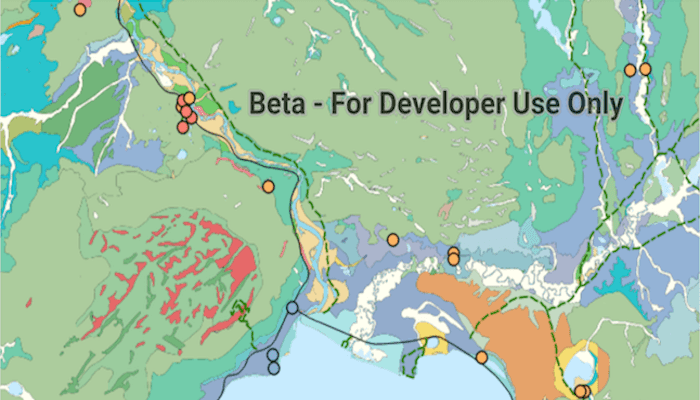Display a map from a mobile map package.

Use case
A mobile map package is an archive containing the data (specifically, basemaps and features) used to display an offline map.
How to use the sample
When the sample opens, it will automatically display the map in the mobile map package. Pan and zoom to observe the data from the mobile map package.
How it works
- Create a
MobileMapPackagespecifying the path to the .mmpk file. - Load the mobile map package with
mmpk.loadAsync(). - After it successfully loads, get the map from the .mmpk and add it to the map view:
mapView.setMap(mmpk.getMaps().get(0)).
Relevant API
- MapView
- MobileMapPackage
Offline Data
- Download the data from ArcGIS Online.
- Open your command prompt and navigate to the folder where you extracted the contents of the data from step 1.
- Push the data into the scoped storage of the sample app:
adb push Yellowstone.mmpk /Android/data/com.esri.arcgisruntime.sample.openmobilemappackage/files/Yellowstone.mmpk
About the data
This sample shows points of interest within a Yellowstone Mobile Map Package hosted on ArcGIS Online.
Tags
mmpk, mobile map package, offline
Sample Code
/* Copyright 2016 Esri
*
* Licensed under the Apache License, Version 2.0 (the "License");
* you may not use this file except in compliance with the License.
* You may obtain a copy of the License at
*
* http://www.apache.org/licenses/LICENSE-2.0
*
* Unless required by applicable law or agreed to in writing, software
* distributed under the License is distributed on an "AS IS" BASIS,
* WITHOUT WARRANTIES OR CONDITIONS OF ANY KIND, either express or implied.
* See the License for the specific language governing permissions and
* limitations under the License.
*
*/
package com.esri.arcgisruntime.sample.openmobilemappackage;
import android.os.Bundle;
import android.util.Log;
import android.widget.Toast;
import androidx.appcompat.app.AppCompatActivity;
import com.esri.arcgisruntime.loadable.LoadStatus;
import com.esri.arcgisruntime.mapping.MobileMapPackage;
import com.esri.arcgisruntime.mapping.view.MapView;
public class MainActivity extends AppCompatActivity {
private static final String TAG = MainActivity.class.getSimpleName();
private MapView mMapView;
// objects that implement Loadable must be class fields to prevent being garbage collected before loading
private MobileMapPackage mMapPackage;
@Override
protected void onCreate(Bundle savedInstanceState) {
super.onCreate(savedInstanceState);
setContentView(R.layout.activity_main);
// get a reference to the map view
mMapView = findViewById(R.id.mapView);
//[DocRef: Name=Open Mobile Map Package-android, Category=Work with maps, Topic=Create an offline map]
// create the mobile map package
mMapPackage = new MobileMapPackage(getExternalFilesDir(null) + getString(R.string.yellowstone_mmpk));
// load the mobile map package asynchronously
mMapPackage.loadAsync();
// add done listener which will invoke when mobile map package has loaded
mMapPackage.addDoneLoadingListener(() -> {
// check load status and that the mobile map package has maps
if (mMapPackage.getLoadStatus() == LoadStatus.LOADED && !mMapPackage.getMaps().isEmpty()) {
// add the map from the mobile map package to the MapView
mMapView.setMap(mMapPackage.getMaps().get(0));
} else {
String error = "Error loading mobile map package: " + mMapPackage.getLoadError().getMessage();
Log.e(TAG, error);
Toast.makeText(this, error, Toast.LENGTH_SHORT).show();
}
});
//[DocRef: END]
}
@Override
protected void onPause() {
super.onPause();
mMapView.pause();
}
@Override
protected void onResume() {
super.onResume();
mMapView.resume();
}
@Override
protected void onDestroy() {
super.onDestroy();
mMapView.dispose();
}
}